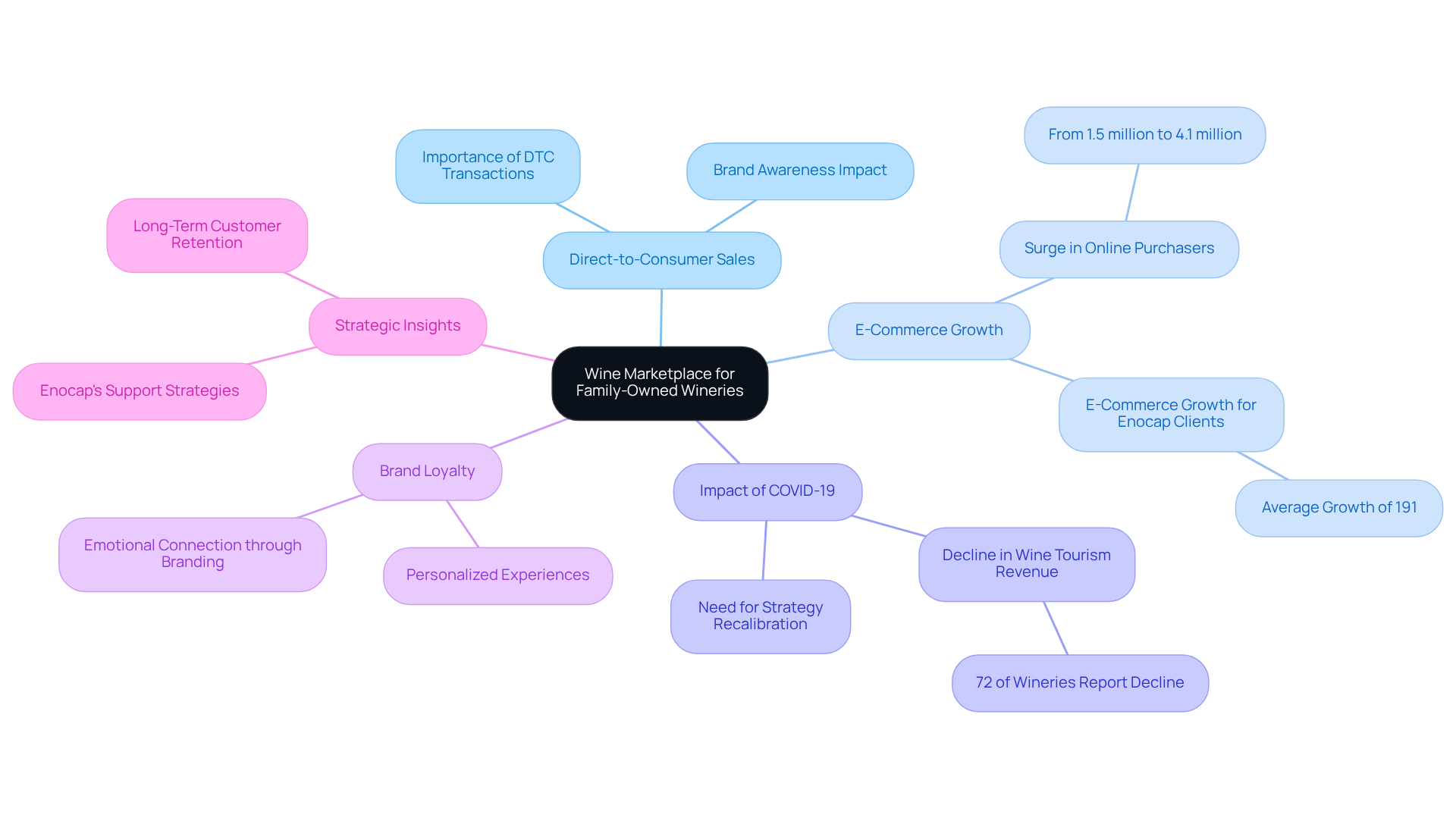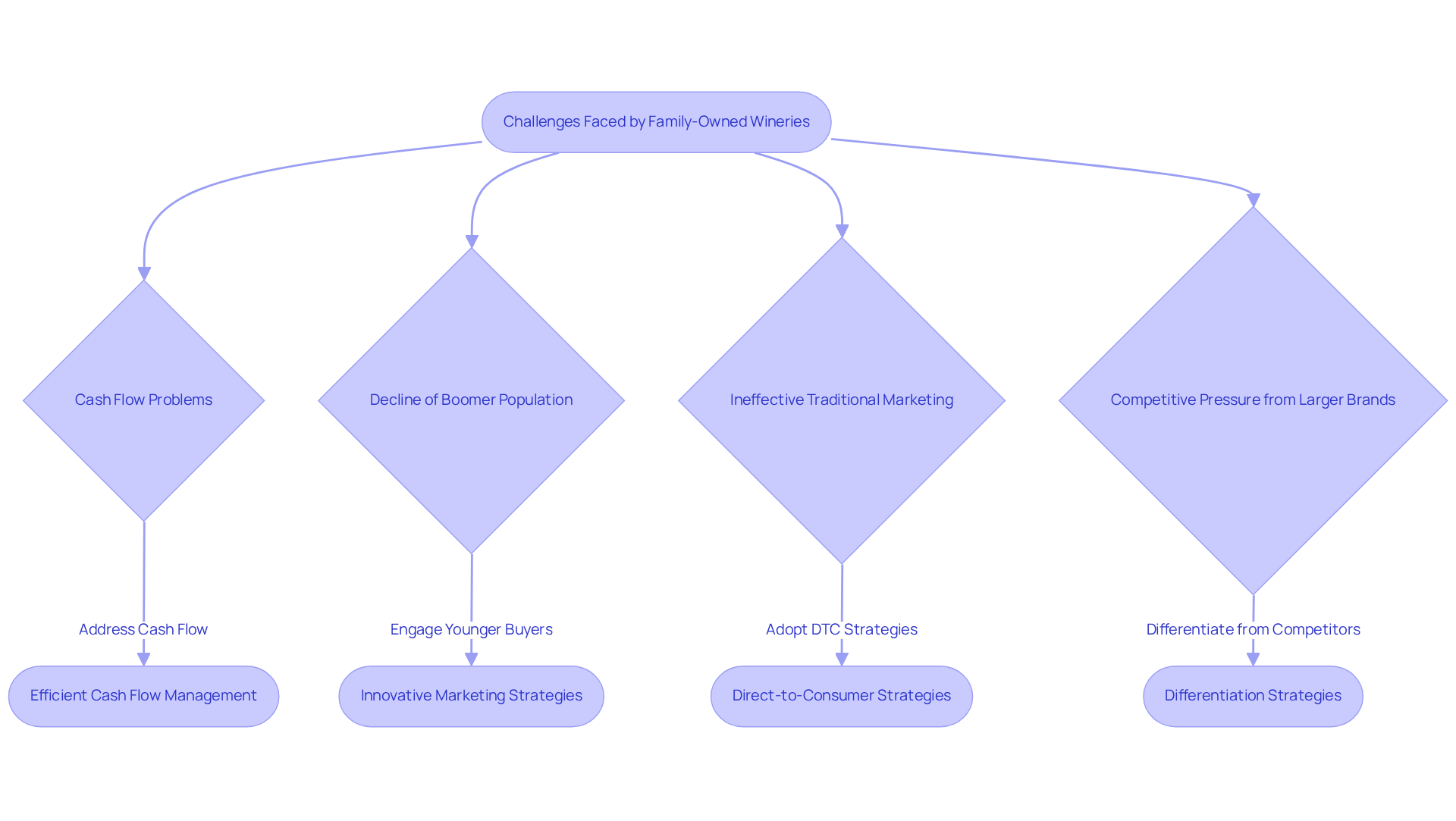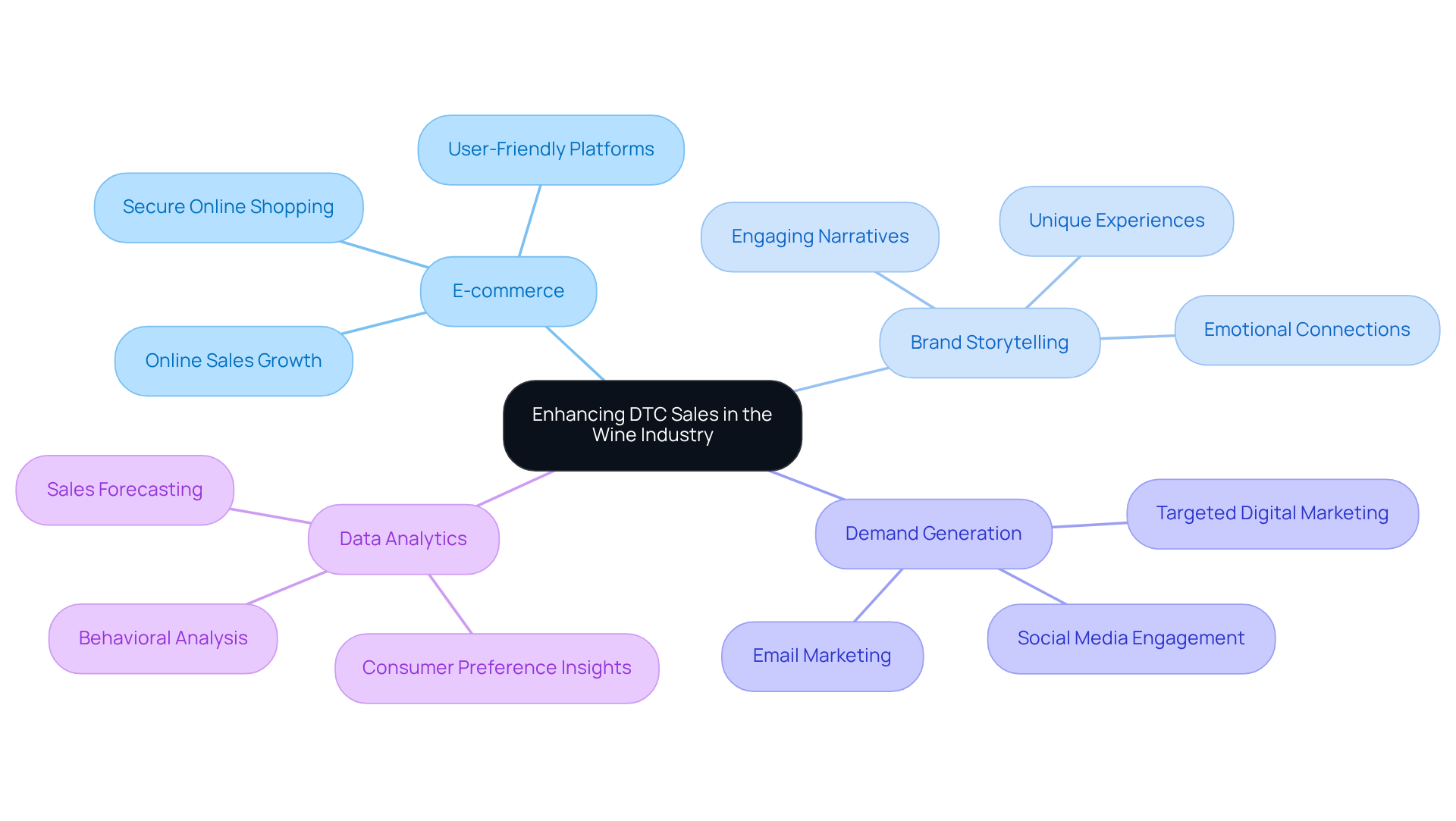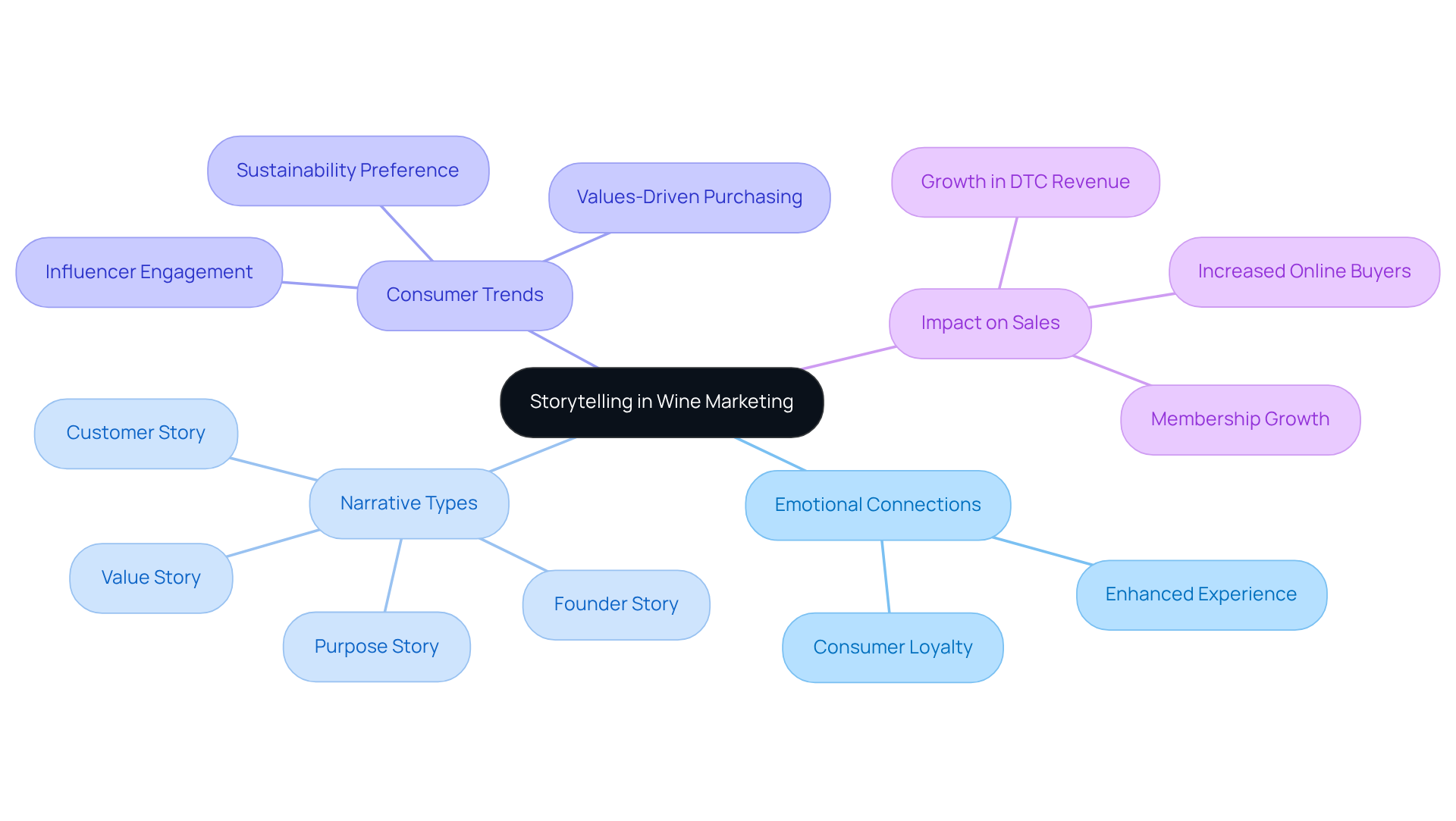Overview
The wine marketplace plays a pivotal role for family-owned wineries, serving as a vital conduit for direct-to-consumer sales that are essential for their sustainability in an increasingly competitive market. By leveraging e-commerce and the power of storytelling, these wineries not only enhance their sales but also cultivate brand loyalty. This strategic approach empowers them to effectively navigate the challenges posed by larger brands and the evolving preferences of consumers. As such, it is imperative for wineries to embrace these methods to secure their position in the market.
Introduction
The wine industry, steeped in tradition and heritage, confronts a significant modern challenge as family-owned wineries endeavor to preserve their unique identities amid intense competition from larger brands. The rise of the wine marketplace presents these smaller producers with a crucial opportunity, allowing them to connect directly with consumers and foster enduring relationships. Yet, as the market landscape transforms, the pressing question arises: how can these vineyards harness this marketplace not merely to survive but to flourish in an increasingly saturated field? Delving into the pivotal role of the wine marketplace uncovers both the opportunities and challenges that family-owned wineries must adeptly navigate to secure their future.
The Critical Role of the Wine Marketplace for Family-Owned Wineries
serves as a vital channel for family-owned vineyards to engage directly with buyers. In a landscape where traditional distribution often favors larger brands, the ability to connect through direct-to-consumer (DTC) transactions is paramount. This wine marketplace not only drives sales but also fosters relationships between wine producers and their customers, offering personalized experiences that bolster brand loyalty.
Moreover, the surge of e-commerce has reshaped the industry, allowing vineyards to reach a wider audience and adapt to evolving consumer behaviors. Notably, the number of online beverage purchasers surged from 1.5 million to 4.1 million, underscoring the growing importance of e-commerce within the alcohol sector.
As family-owned vineyards endeavor to maintain their legacy while navigating a modern market, understanding and leveraging the wine marketplace is essential for sustainable growth and enduring viability. However, the COVID-19 pandemic posed significant challenges, with 72% of vineyards reporting a decline in wine tourism revenue exceeding 10%. This situation highlights the pressing need for vineyards to recalibrate their strategies.
Furthermore, brand awareness plays a crucial role in driving DTC revenue, as producers with robust brand identities are better positioned to attract customers. As Rob McMillan aptly notes, "Today’s direct-to-consumer sales channels provide insights into new opportunities," emphasizing the imperative for vineyards to innovate and differentiate themselves.
Enocap's proven strategies for transforming casual purchasers into loyal club members, combined with its strategic capital planning services, can further support producers in navigating these complexities, ensuring they remain competitive in an ever-evolving industry.

Challenges Faced by Family-Owned Wineries in a Competitive Market
Family-operated vineyards are navigating a complex and competitive environment in the wine marketplace, grappling with significant challenges that threaten their sustainability. Cash flow problems stand as a primary concern, often hindering these establishments from investing in essential marketing and operational improvements. Industry specialists assert that efficient cash flow management is crucial for success, particularly as these vineyards adapt to shifting buyer preferences and market dynamics.
The decline of the Boomer population has intensified the urgency for vineyards to engage with younger buyers, who are progressively emerging as the primary market. Traditional marketing strategies have proven less effective, necessitating innovative approaches to connect with this demographic. Enocap's transformative direct-to-consumer strategies empower producers to establish sustainable channels that drive consistent growth, converting casual buyers into devoted club members through effective storytelling techniques. Case studies, such as those from Sula Vineyards and Podere Riosto, illustrate how family-owned producers can leverage these strategies and digital channels to enhance their market presence and foster loyalty among consumers aged 30 to 45. Notably, Rajeev Samant's experience during the Great Recession exemplifies resilience and .
Moreover, the competitive pressure from larger brands and the surge in online beverage transactions further complicate the wine marketplace. Family-owned vineyards must not only preserve their unique identities and heritage but also adopt strategic measures to differentiate themselves. This includes optimizing direct-to-consumer sales channels in the wine marketplace, where 27% of new wine club signups originate from digital platforms, and utilizing data analytics to inform financial decisions and marketing strategies. Enocap's strategic capital planning can assist vineyards in navigating debt, equity, or acquisition opportunities, ensuring they remain competitive and secure the necessary capital for growth.
Without a proactive and strategic approach to these challenges, many family-owned vineyards may find it increasingly difficult to survive in an overcrowded marketplace. Emphasizing the importance of cash flow management, consumer connection, and competitive differentiation is essential for these establishments to thrive in 2025 and beyond. As Matthew J. Prieb, CPA, observes, vineyards must blend fresh concepts with sound financial practices to navigate these turbulent times effectively.

Strategies for Enhancing Direct-to-Consumer Sales in the Wine Industry
To elevate direct-to-consumer revenue, family-owned vineyards must adopt a multifaceted strategy that encompasses and engaging brand storytelling. Establishing robust DTC revenue channels is paramount, achievable through enhanced e-commerce platforms and enticing club memberships that transform casual purchasers into loyal members.
By 2025, establishments that effectively harness e-commerce can expect remarkable growth, as evidenced by a 191% average increase in online sales for clients of consulting firms like Enocap. Implementing robust demand generation techniques, such as targeted digital marketing campaigns and social media engagement, can significantly boost visibility and attract new customers. Notably, 27% of new beverage club signups now originate from digital channels, underscoring the critical importance of online engagement.
Furthermore, leveraging data analytics to understand consumer preferences and behaviors empowers vineyards to tailor their offerings and marketing strategies. By focusing on these transformative strategies, including strategic capital planning for debt, equity, or acquisition opportunities, family-owned businesses in the sector can not only enhance their sales but also cultivate enduring relationships with their customers, ensuring long-term success and sustainability in the competitive beverage industry.

The Power of Storytelling and Brand Engagement in Wine Marketing
In the wine marketplace, storytelling serves as a pivotal differentiator for family-owned vineyards. By weaving narratives that emphasize their heritage, values, and unique production techniques, these establishments forge emotional connections with customers. Engaging brand stories not only enhance the consumer experience but also foster loyalty and encourage repeat purchases. Various media platforms—such as social media, blogs, and video content—enable vineyards to effectively disseminate their narratives and expand their audience reach.
Enocap's digital brand narrative development, alongside its media placement and PR strategies, empowers producers in the wine marketplace to unlock direct-to-consumer revenue and transform casual buyers into devoted club members through established methods. As modern consumers increasingly prioritize authenticity and connection in their purchasing decisions, the power of storytelling emerges as an essential asset for family-owned vineyards striving to excel in a competitive landscape.
This strategy aligns with the growing trend of values-driven purchasing, evidenced by the fact that 66% of U.S. beverage purchasers prefer sustainably produced options. This trend underscores the necessity for producers to communicate their and community engagement through compelling stories.
Furthermore, case studies highlight the critical role of storytelling in the wine marketplace, emphasizing four key narrative types—value, founder, purpose, and customer—that wineries should convey to effectively engage their audience. Enocap's strategies have yielded significant outcomes, with the number of online wine buyers soaring from 1.5 million to 4.1 million. This demonstrates how effective storytelling and brand engagement can not only drive sales but also nurture deeper consumer connections, while concurrently supporting strategic capital planning for sustainable growth, including avenues for debt, equity, or acquisition.

Conclusion
The wine marketplace stands as more than just a sales platform; it serves as a lifeline for family-owned wineries striving to uphold their unique identities amidst fierce competition. By facilitating direct-to-consumer interactions, these marketplaces empower smaller producers to forge meaningful relationships with customers, thereby fostering brand loyalty and driving sustainable growth. In a landscape often dominated by larger brands, the ability to engage directly with consumers becomes essential for the survival and success of family-owned vineyards.
Key insights throughout the article illuminate the multifaceted challenges these wineries face, including:
- Cash flow management
- Evolving consumer demographics
- The imperative for innovative marketing strategies
As younger buyers emerge as a significant market force, family-owned vineyards must recalibrate their approaches to resonate with this demographic. The critical importance of storytelling and brand engagement is underscored, as these elements evolve into vital tools for differentiation and enhancement of direct-to-consumer sales.
Ultimately, family-owned wineries must acknowledge the pivotal role of the wine marketplace within their business strategies. By embracing e-commerce, leveraging data analytics, and crafting compelling narratives, these producers can adeptly navigate the complexities of the modern wine industry. The call to action is unmistakable: investing in these strategies not only bolsters immediate sales growth but also secures a lasting legacy in the ever-evolving world of wine.
Frequently Asked Questions
What is the role of the wine marketplace for family-owned wineries?
The wine marketplace serves as a vital channel for family-owned vineyards to engage directly with buyers, driving sales and fostering relationships that enhance brand loyalty through direct-to-consumer transactions.
How has e-commerce affected the wine industry?
E-commerce has reshaped the wine industry by allowing vineyards to reach a wider audience and adapt to changing consumer behaviors, with the number of online beverage purchasers increasing from 1.5 million to 4.1 million.
What challenges did family-owned vineyards face during the COVID-19 pandemic?
The COVID-19 pandemic posed significant challenges, with 72% of vineyards reporting a decline in wine tourism revenue exceeding 10%, highlighting the need for vineyards to adjust their strategies.
Why is brand awareness important for vineyards?
Brand awareness is crucial for driving direct-to-consumer revenue, as producers with strong brand identities are better positioned to attract customers and capitalize on sales opportunities.
What strategies can help vineyards maintain competitiveness?
Strategies such as transforming casual purchasers into loyal club members and implementing strategic capital planning services can help vineyards navigate industry complexities and remain competitive.




